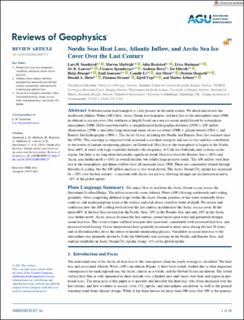| dc.contributor.author | Smedsrud, Lars Henrik | |
| dc.contributor.author | Muilwijk, Morven | |
| dc.contributor.author | Eldevik, Tor | |
| dc.contributor.author | Årthun, Marius | |
| dc.contributor.author | Brakstad, Ailin | |
| dc.contributor.author | Madonna, Erica | |
| dc.contributor.author | Lauvset, Siv Kari | |
| dc.contributor.author | Spensberger, Clemens | |
| dc.contributor.author | Born, Andreas | |
| dc.contributor.author | Drange, Helge | |
| dc.contributor.author | Jeansson, Emil | |
| dc.contributor.author | Li, Camille | |
| dc.contributor.author | Olsen, Are | |
| dc.contributor.author | Skagseth, Øystein | |
| dc.contributor.author | Slater, Donald | |
| dc.contributor.author | Straneo, Fiammetta | |
| dc.contributor.author | Våge, Kjetil | |
| dc.date.accessioned | 2022-01-28T10:17:17Z | |
| dc.date.available | 2022-01-28T10:17:17Z | |
| dc.date.created | 2021-12-13T10:40:12Z | |
| dc.date.issued | 2021 | |
| dc.identifier.issn | 8755-1209 | |
| dc.identifier.uri | https://hdl.handle.net/11250/2932835 | |
| dc.description.abstract | Poleward ocean heat transport is a key process in the earth system. We detail and review the northward Atlantic Water (AW) flow, Arctic Ocean heat transport, and heat loss to the atmosphere since 1900 in relation to sea ice cover. Our synthesis is largely based on a sea ice-ocean model forced by a reanalysis atmosphere (1900-2018) corroborated by a comprehensive hydrographic database (1950-), AW inflow observations (1996-), and other long-term time series of sea ice extent (1900-), glacier retreat (1984-) and Barents Sea hydrography (1900-). The Arctic Ocean, including the Nordic and Barents Seas, has warmed since the 1970s. This warming is congruent with increased ocean heat transport and sea ice loss and has contributed to the retreat of marine-terminating glaciers on Greenland. Heat loss to the atmosphere is largest in the Nordic Seas (60% of total) with large variability linked to the frequency of Cold Air Outbreaks and cyclones in the region, but there is no long-term statistically significant trend. Heat loss from the Barents Sea (∼30%) and Arctic seas farther north (∼10%) is overall smaller, but exhibit large positive trends. The AW inflow, total heat loss to the atmosphere, and dense outflow have all increased since 1900. These are consistently related through theoretical scaling, but the AW inflow increase is also wind-driven. The Arctic Ocean CO2 uptake has increased by ∼30% over the last century - consistent with Arctic sea ice loss allowing stronger air-sea interaction and is ∼8% of the global uptake. | en_US |
| dc.language.iso | eng | en_US |
| dc.publisher | American Geophysical Union | en_US |
| dc.relation.uri | https://agupubs.onlinelibrary.wiley.com/doi/10.1029/2020RG000725 | |
| dc.rights | Navngivelse-Ikkekommersiell 4.0 Internasjonal | * |
| dc.rights.uri | http://creativecommons.org/licenses/by-nc/4.0/deed.no | * |
| dc.title | Nordic Seas Heat Loss, Atlantic Inflow, and Arctic Sea Ice cover over the last century | en_US |
| dc.type | Journal article | en_US |
| dc.type | Peer reviewed | en_US |
| dc.description.version | publishedVersion | en_US |
| dc.rights.holder | © 2021 The Authors. | en_US |
| dc.source.articlenumber | e2020RG000725 | en_US |
| cristin.ispublished | true | |
| cristin.fulltext | original | |
| cristin.qualitycode | 2 | |
| dc.identifier.doi | 10.1029/2020RG000725 | |
| dc.identifier.cristin | 1967628 | |
| dc.source.journal | Reviews of Geophysics | en_US |
| dc.relation.project | Norges forskningsråd: 276730 | en_US |
| dc.identifier.citation | Reviews of Geophysics. 2021,60, e2020RG000725 | en_US |
| dc.source.volume | 60 | en_US |
| dc.source.issue | 1 | en_US |

